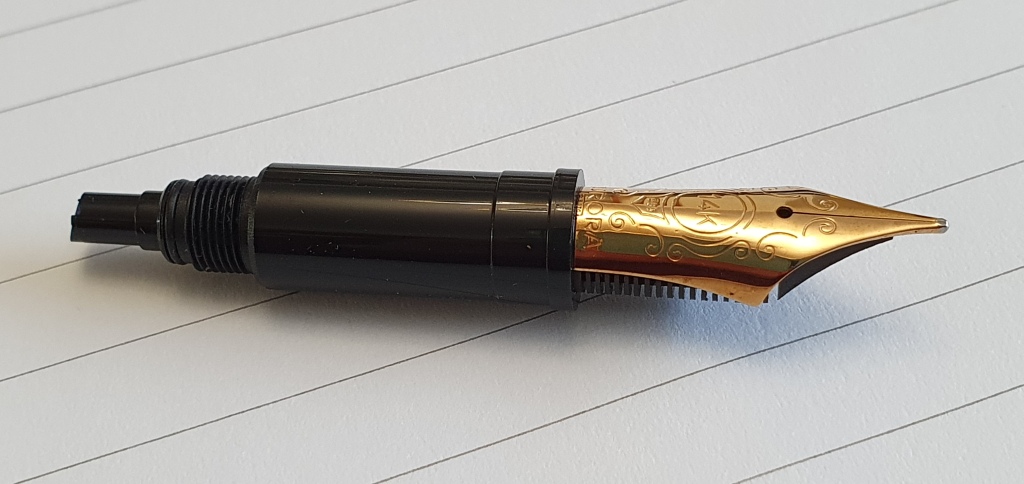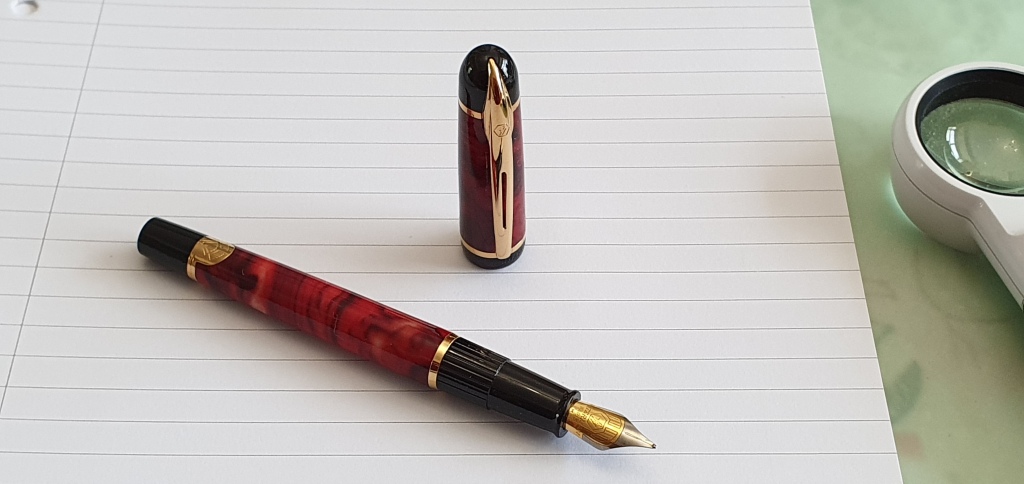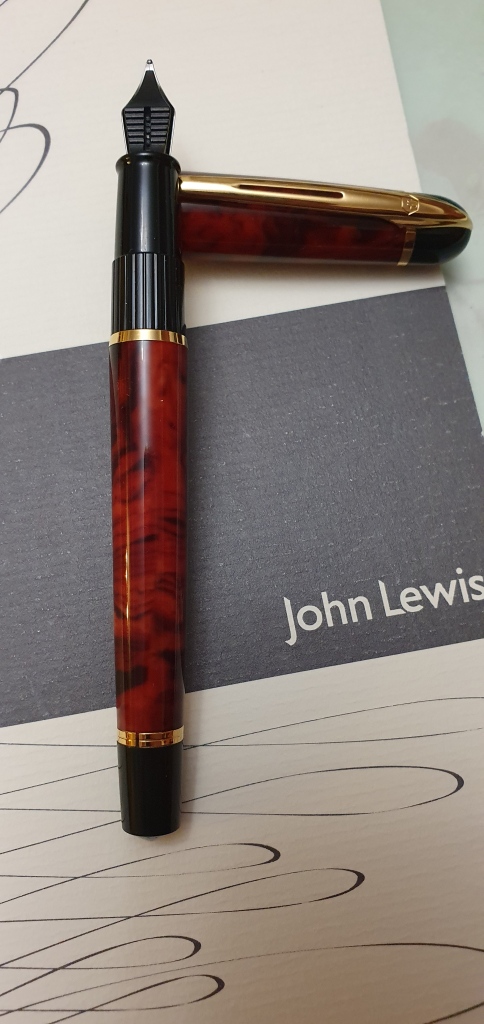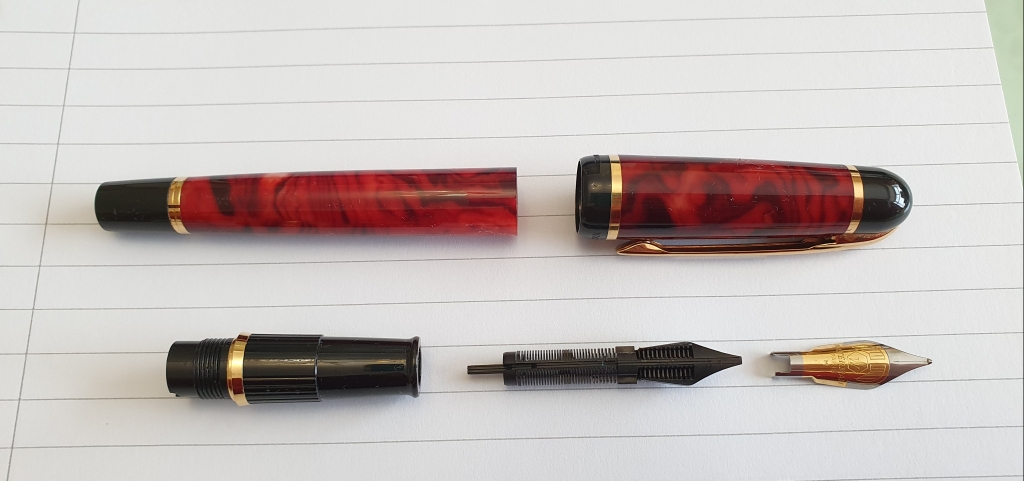It has been a year to the day, since my Aurora 88 arrived in the mail, as told in my post Some early thoughts on the Aurora 88 fountain pen. That same pen has been the focus of my attention over the last few days and it seems timely to give an update.
The pen is magnificent and has “the wow factor” whenever it is produced. People exclaim “What a gorgeous pen!”

It has remained inked since I bought it, as befits a pen which is almost my most costly to date. Looking at my records, I see that I have filled it with seven different inks over this time, starting with the obvious Aurora Blue, then Aurora Blue Black, Graf von Faber-Castell Cobalt Blue, Montblanc Irish Green, Diamine Tavy, Cult Pens Deep Dark Red, Aurora Blue Black (again) and then Waterman Intense Black.

The pen is a joy to look at and to hold. The only problem was that the written line was not as bold and juicy as I had expected. Although described as a Medium nib, the resulting line was a Fine by most people’s standards. That in itself was not an issue for me as I enjoy a good fine nib too. However it was so fine and so thin and pale that on some papers, it would look like the work of a needlepoint. Generally speaking I am a fan of blue black inks as preferable to black, but in this case I had resorted to trying Waterman Intense Black, in an effort to make a more contrasty line. The result was anything but intense. More like a pale grey.
I have an abundance of notebooks with different paper types. Some of these make a pen write finer whilst others make it write broader. I found that I could compensate for my Aurora’s fineness by using it on a Radley A5 notebook, which tends to make the line slightly broader, yet without any apparent feathering or bleedthrough.
For a long time, I had avoided trying to adjust precious gold nibs, (apart from simple tine alignment) for fear of damaging them. I am happy to have a go with a steel nib, giving it a tweak here and there to improve flow or to smooth the tipping but most gold nibs I left alone.
I think the turning point came when I realised earlier this summer that I had not made much use of my Lamy 2000 in six years, as the broad nib was dry and hard going. I had reached a point when (a) I had accumulated some knowledge and experience of what was wrong and what was needed; (b) I was sufficiently confident to have a go and (c) the pen was six years old and I had little to lose and was “past caring”: a certain blend of know how and recklessness. As luck would have it, I was able in a few minutes, to open up the tines of the Lamy and improve wetness and flow considerably. I was thrilled with the transformation. More confidence to me.
A few weeks ago I ordered a set of brass shims online. These enabled me to floss nibs and clean out accumulated paper fibres. I had imagined that it might not be that hard to floss nibs with shims of increasing thickness and so make slight adjustment to tine spacing. It is not quite that simple. I watched a Brian Goulet tutorial video about using brass shims although his emphasis was on cleaning between the tines, rather than adjusting the gap.
When the brass shims came, I tried them out first on a Sheaffer Crest, with its distinctive conical nib in bicolour 18k gold but which was dry and hard to use. I wanted to achieve a very slight widening of the tine gap. After a few goes with my brass shims, I very carefully inserted the point of a craft knife, just below the breather hole, and brought the blade down into the gap as low as it would go. I was then able to wriggle it very gently from side to side to get a little more space between the tines. Gold does bend quite easily but you need to push it just past the point at which it will spring back again, so that it stays.
As with all nib work the advice is go to very carefully and check the results frequently with a loupe and with a writing test to check the outcome. When I discovered the Sheaffer now writing effortlessly I was very happy and relieved.
Encouraged by my success with the Sheaffer, I formed the idea of tackling the Aurora 88 nib in the same way. I rehearsed the operation in my head on my two mile walk home from work, as if it were a rocket launch.
Nib work on the Aurora.
The process involved three stages:-
- Flossing the nib first with the finest grade of brass shim.
- Inserting the scalpel and doing some extremely gentle twisting right and left to spread the tines. It is best to lower as much of the blade into the gap as you can, to avoid “chewing up” the gold surface along the top of the tines.
- Once happy with the outcome, checking for tine alignment and doing some final smoothing (the minimum needed) on micromesh pads.
The pen remained inked through this process although at the end, I unscrewed the nib unit and rinsed it, to inspect the results of my handiwork.

Conclusion.
It probably goes without saying that working on a nib, especially with metal tools, is risky and can result in damage. You do so at your own risk. But having said that, it is possible with a little courage and practice to improve a nib and so save yourself the frustration of disappointing nibs.
To the eye, the Aurora nib now looks no different from before. However the ink flow is now more generous. This increases line width and lubrication and makes for a more pleasurable and effortless writing experience. It is better to spread the tines in the way described here, rather than use the short cut of bending the tines upwards which can spoil the look of a nib.
I now plan to re-try my ink choices. Once the Intense Black is finished, I will try Aurora Blue once again in the eager anticipation of seeing the ink flow from this pen in its true vibrant colours.

















